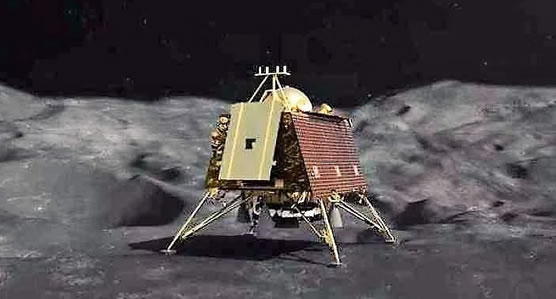Establishing communication with the Vikram lander of Chandrayan 2, is impossible (An individual logical opinion)
Thirupalu
Sep 19, 2019 19:01 PM

The Vikram lander lost the communication before it's touchdown on the surface of the moon. So it is wrong to say that only due to hard landing, the communication was lost. First, it happened due to the technical fault while Vikram lander was in its touch down trajectory and later, further damage might have been due the hard landing. Hence, if you want to restore the communication with the lander, the technical fault and the damage, if any, are to be corrected. That is not possible just by using IDSN (Indian Deep Space Network) or DSN (Deep Space Network of NASA). That can be possible, I think, only when any robot or human goes there and corrects them, which is impossible in this short period of time. So, it is mere waste of time, energy and resources to try for establishing communication with the lander.
The mission Chandraayan 2 is a mission which redefined space travel in terms of the cost, though it is 95 % success. The credit goes purely to the scientists of ISRO.
But, the lander Vikram's touchdown trajectory is concerned, the touchdown was not successful. In my opinion, the following may be the reasons.
1. It may be due to climatic conditions such as temperature, pressure, etc, unexpected radiation, gravitational pull, hills, etc and unforecast chemical composition of the moon's atmosphere might have obstructed the transmission of communicating radio waves, which were beyond human control at that point of time.
2. It may be the manufacturing technical flaw in the transmission system.
3. It may be due to the human error in communication with the lander due to the ignorance, anxiety, fear of failure, etc.
The above analysis is required for the success of future missions.
The above issues might have been settled, in my opinion, if an artificial intelligent robot was integrated in the mission.
And the design of the lander was meant only for vertical landing with the legs faicng the surface of the moon.
The landing may be affected by the different unforecast conditions. Due to those unforecast conditions, it may happen that the vertical landing may not be possible. In such situations, the design of the lander should be such that it may cope up with any type of landing to avoid damage to the lander and the payloads.
It may also be possible that there may be the liquified/mud terrain. The lander may sink or trap in the mud.
Seeing all these possibilities, I think, in the future missions scientists have to rethink about the present practice of designing the lander.
And, presently, as I wrote in the earlier lines of the article, it is impossible and mere waste of time, energy and resources to try to establish the communication with the lander in this very short period of time.
The scientists should thank the Vikram lander for teaching these many lessons which surely help in the space missions to come.
The above is my individual logical. opinion. That is all.
Long live India ! Long live ISRO !
Jaihind ! Jai Bharat !
Comments